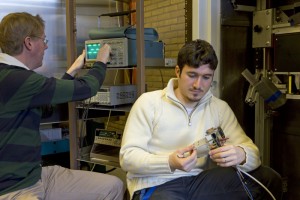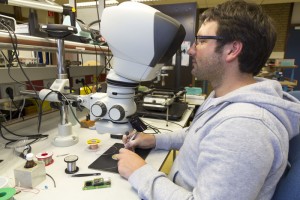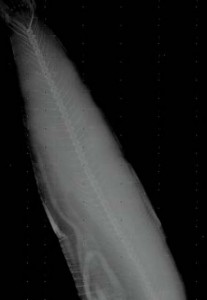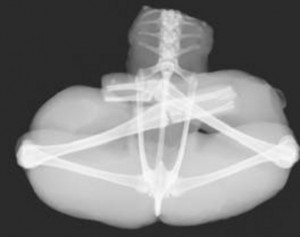Momenteel kunnen we deze pagina alleen in het Engels aanbieden.
The Medipix consortia are hosted by CERN and aim to design read-out chips that are implemented in various applications with hybrid-pixel detector technology, which was originally invented for high-energy-physics experiments.
The first proof of principle chip was made in 1997 and since then different generations have been developed, which are listed below with the main characteristics, and between brackets the CMOS technology in which the chips were made is indicated. Nikhef has been a founding member of the Medipix2, 3 & 4 collaborations and has played a significant role in the development of read-out systems and has become involved in the chip design part starting with the Timepix3 chip.
Nikhef has been an active partner in starting with the Medipix2 collaboration:
1997: Medipix1 (1 µm)
- Proof of principle with small matrix and large pixels
1999: Medipix2 (0.25 µm)
- Photon counting
- Commercialised by PANalytical in the field of X-ray diffraction
2005: Timepix (0.25 µm)
- 10 ns timing resolution to read out time projection chambers
2006: Medipix3 (0.13 µm)
- Charge summing circuitry to combat charge sharing between pixels
- Spectroscopic mode to use energy information of X-rays
2011: Timepix3 (0.13 µm)
- Data-driven read-out to reduce data volume in sparse data applications
- 6 ns timing resolution based on Gossipo chips from Nikhef
2016: Medipix4 and Timepix4 (65 nm)
- 4-side buttable for tiling large areas
- Medipix4 chip: better spectroscopic and photon flux capabilities
- Timepix4 chip: 200 picosecond time resolution
The Medipix based hybrid-pixel-detectors are photon counting devices that can operate free from electronic noise, making them suited for long exposure times. In combination with their large dynamic range this allows the discrimination of small differences in particle flux at both low and high rates. Over the years these chips have found their way into many applications (links to 10 years MPX2 and 10 years MPX3 papers of Michael Campbell).
At Nikhef or in close collaboration with Nikhef the following applications have been developed:
- Spectral X-ray Computed Tomography imaging
- Spectral X-ray mammography
- Proton radiography with Timepix based time projection chambers (IEEE papers)
- Development of fast timing circuits in Gossipo test chips applied in Timepix3
- Mass spectrometry with AMOLF
- Electron Microscopy with Leiden
- Start of spin-off company Amsterdam Scientific Instruments (ASI) (2011). Amsterdam Scientific Instruments sells Medipix and Timepix based systems to the scientific community for X-ray analysis, mass spectrometry and electron microscopy. These technologies are used for instance to study the history of paintings, determine the distribution of elements in tissue, and molecules e.g. proteins and medicine as well as biological nano-crystals.
- Commercial use by PANalytical in X-ray diffraction analysis of materials.
PANalytical was the first company that implemented the Medipix technology in their X-ray diffraction (XRD) products in 2007 and ever since. XRD is widely used to reveal structural information, such as chemical composition, crystal structure, crystallite size, strain, preferred orientation and layer thickness.
If you would like to know more, please contact Dr. Jan Visser:
Science Park 105
1098 XG Amsterdam
The Netherlands
t: +31-20-5925098
e-mail janvs@nikhef.nl




